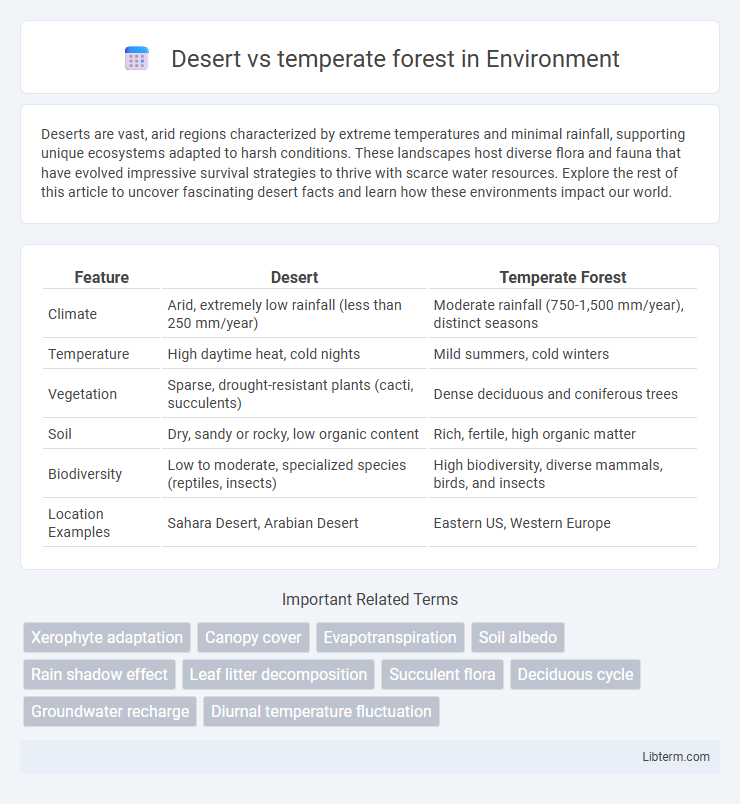Deserts are vast, arid regions characterized by extreme temperatures and minimal rainfall, supporting unique ecosystems adapted to harsh conditions. These landscapes host diverse flora and fauna that have evolved impressive survival strategies to thrive with scarce water resources. Explore the rest of this article to uncover fascinating desert facts and learn how these environments impact our world.
Table of Comparison
| Feature | Desert | Temperate Forest |
|---|---|---|
| Climate | Arid, extremely low rainfall (less than 250 mm/year) | Moderate rainfall (750-1,500 mm/year), distinct seasons |
| Temperature | High daytime heat, cold nights | Mild summers, cold winters |
| Vegetation | Sparse, drought-resistant plants (cacti, succulents) | Dense deciduous and coniferous trees |
| Soil | Dry, sandy or rocky, low organic content | Rich, fertile, high organic matter |
| Biodiversity | Low to moderate, specialized species (reptiles, insects) | High biodiversity, diverse mammals, birds, and insects |
| Location Examples | Sahara Desert, Arabian Desert | Eastern US, Western Europe |
Introduction: Contrasting Ecosystems
Deserts and temperate forests represent contrasting ecosystems characterized by distinct climatic conditions and biodiversity. Deserts experience extreme aridity with minimal precipitation, supporting specialized flora and fauna adapted to harsh, dry environments. Temperate forests exhibit moderate rainfall and seasonal changes, fostering diverse plant species and a rich variety of wildlife.
Climate and Weather Patterns
Deserts experience extreme temperature fluctuations with scorching daytime heat often exceeding 40degC and nighttime temperatures dropping sharply, accompanied by minimal annual rainfall typically under 250 mm. Temperate forests exhibit moderate seasonal variations, with warm summers averaging 20-30degC and cold winters near or below freezing, receiving substantial precipitation ranging from 750 mm to 1,500 mm annually. The consistent moisture in temperate forests supports dense vegetation, contrasting sharply with the arid, sparse landscape of deserts shaped by prolonged drought and evaporation.
Soil Composition and Fertility
Desert soils are typically sandy, low in organic matter, and have poor water retention, resulting in limited nutrient availability and low fertility. In contrast, temperate forest soils are rich in organic material from abundant leaf litter, supporting higher nutrient content and greater fertility. The increased microbial activity and moisture in temperate forest soils further enhance nutrient cycling compared to the arid, nutrient-poor desert soils.
Biodiversity and Key Species
Deserts exhibit lower biodiversity compared to temperate forests due to extreme temperatures and limited water availability, supporting specialized species like cacti, camels, and scorpions adapted to arid conditions. Temperate forests boast higher biodiversity with a variety of hardwood trees such as oaks and maples, alongside key species like deer, black bears, and numerous bird species that thrive in dense vegetation and seasonal climate. The rich soil and moderate climate in temperate forests facilitate complex ecosystems, while deserts sustain fewer but highly adapted organisms.
Adaptations of Flora
Desert flora exhibits adaptations such as thick, waxy cuticles, deep root systems, and succulent tissues to conserve water and endure extreme heat. Temperate forest plants develop broad leaves for maximum photosynthesis, deciduous habits to survive seasonal cold, and extensive root networks to absorb nutrients in fertile soil. Both ecosystems showcase specialized adaptations that optimize plant survival within their distinct environmental conditions.
Adaptations of Fauna
Desert fauna exhibit adaptations such as nocturnal behavior, water-efficient kidneys, and burrowing to escape extreme heat and conserve moisture. Temperate forest animals develop thick fur, hibernate during winter, and store food to survive seasonal temperature fluctuations. Unique physiological and behavioral traits enable both desert and temperate forest species to thrive in their distinct environments.
Water Availability and Sources
Deserts experience extremely low water availability, with annual precipitation often below 250 millimeters, mostly sourced from infrequent rainstorms and occasional groundwater reserves. Temperate forests receive abundant rainfall ranging from 750 to 1,500 millimeters annually, supplied by consistent precipitation through rain and snow, which supports diverse vegetation and rich soil moisture. The sustained water sources in temperate forests contrast sharply with the sporadic and limited water inputs in desert ecosystems.
Human Impact and Land Use
Desert ecosystems face significant challenges from human activities such as mining, off-road vehicle use, and urban expansion, which lead to habitat fragmentation and soil degradation. Temperate forests experience extensive land use changes due to logging, agriculture, and urban development, causing deforestation and biodiversity loss. Conservation efforts in both biomes focus on sustainable land management practices to mitigate habitat destruction and promote ecosystem resilience.
Ecological Roles and Functions
Deserts regulate global temperature by reflecting solar radiation and support specialized flora and fauna adapted to water scarcity, contributing to nutrient cycling in arid environments. Temperate forests enhance carbon sequestration through dense vegetation, support diverse species that maintain ecosystem balance, and regulate hydrological cycles by influencing precipitation patterns and soil moisture retention. Both ecosystems play crucial roles in sustaining biodiversity and climate stability through distinct ecological processes and functions.
Conservation Challenges and Strategies
Deserts face conservation challenges such as water scarcity, habitat fragmentation, and climate change impacts that threaten specialized flora and fauna adapted to arid conditions. Temperate forests struggle with deforestation, invasive species, and biodiversity loss due to logging and urban expansion, requiring restoration and sustainable management strategies. Conservation strategies in deserts emphasize water resource management and habitat connectivity, while temperate forests benefit from reforestation, protected area establishment, and controlling invasive species to preserve ecological balance.
Desert Infographic

 libterm.com
libterm.com